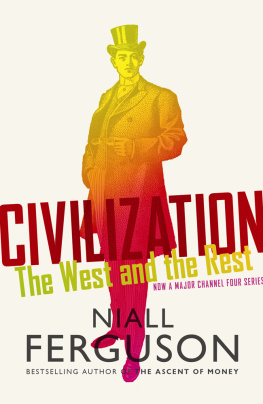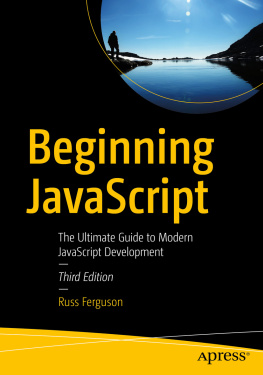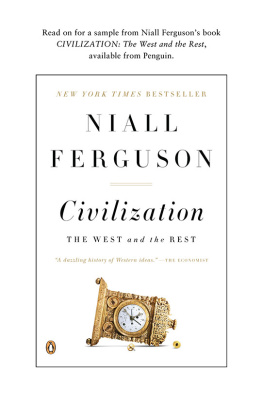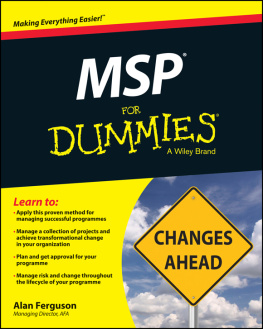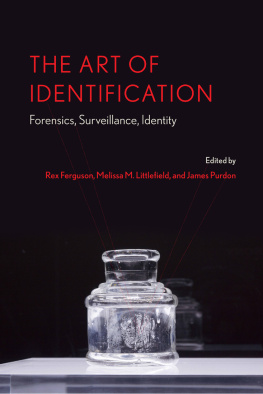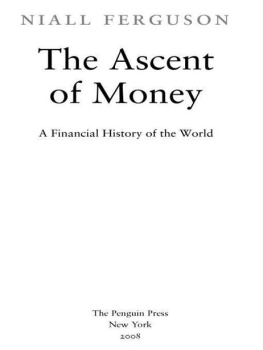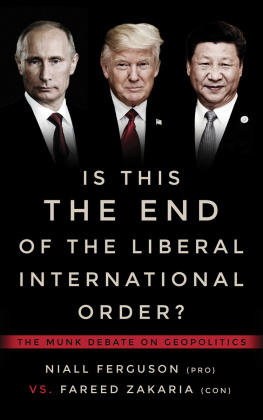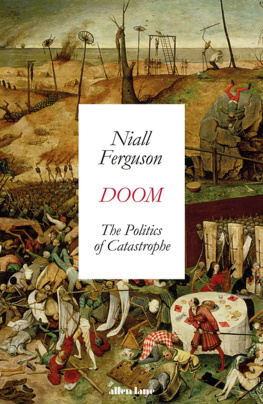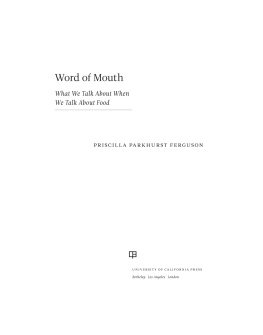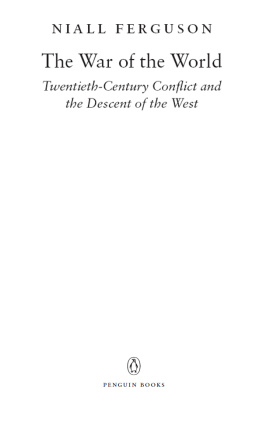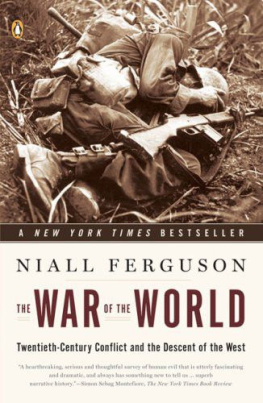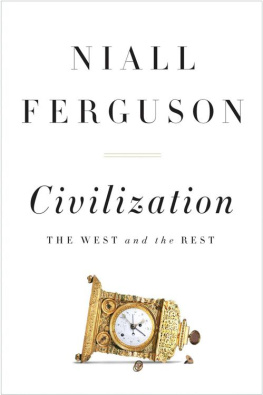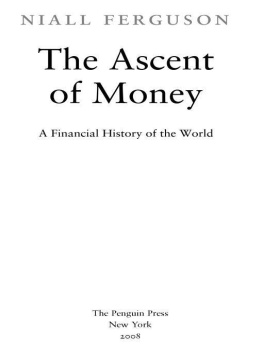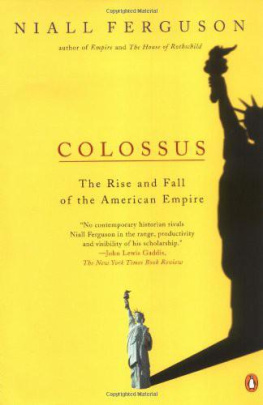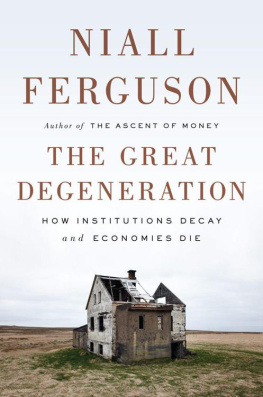NIALL FERGUSON
Civilization
The West and the Rest

ALLEN LANE
an imprint of
PENGUIN BOOKS
ALLEN LANE
Published by the Penguin Group
Penguin Books Ltd, 80 Strand, London WC2R 0RL , England
Penguin Group (USA) Inc., 375 Hudson Street, New York, New York 10014, USA
Penguin Group (Canada), 90 Eglinton Avenue East, Suite 700, Toronto, Ontario, Canada M4P 2Y3
(a division of Pearson Penguin Canada Inc.)
Penguin Ireland, 25 St Stephens Green, Dublin 2, Ireland (a division of Penguin Books Ltd)
Penguin Group (Australia), 250 Camberwell Road, Camberwell, Victoria 3124, Australia (a division of Pearson Australia Group Pty Ltd)
Penguin Books India Pvt Ltd, 11 Community Centre, Panchsheel Park, New Delhi 110 017, India
Penguin Group (NZ), 67 Apollo Drive, Rosedale, Auckland 0632, New Zealand
(a division of Pearson New Zealand Ltd)
Penguin Books (South Africa) (Pty) Ltd, 24 Sturdee Avenue, Rosebank, Johannesburg 2196, South Africa
Penguin Books Ltd, Registered Offices: 80 Strand, London WC2R 0RL , England
www.penguin.com
First published 2011
Copyright Niall Ferguson, 2011
The moral right of the author has been asserted
All rights reserved
Without limiting the rights under copyright reserved above, no part of this publication may be reproduced, stored in or introduced into a retrieval system, or transmitted, in any form or by any means (electronic, mechanical, photocopying, recording or otherwise) without the prior written permission of both the copyright owner and the above publisher of this book
ISBN: 978-1-84-614282-6
For Ayaan
List of Illustrations
Scene from the Hundred Years War (Corbis)
The Four Conditions of Society: Poverty, Jean Bourdichon, c. 1500 (Bridgeman)
The Triumph of Death, Peter Bruegel the Elder, c. 1562 (Getty)
The Yongle Emperor (National Palace Museum, Taiwan)
Su Songs water clock (Adrian Pennink)
A game of Chinese golf (Palace Museum, Forbidden City)
The qilin (Jinghai Temple)
The Chinese civil service examination, from a 17th-century history of Chinese emperors (Bridgeman)
Vasco da Gamas tomb, monastery of St Jerome, Lisbon (Dewald Aukema)
Earl Macartneys embassy to the Xianlong Emperor, cartoon by James Gillray (Getty)
Jan Sobieskis men raise the siege of Vienna (Vienna Museum)
Sultan Osman III (Bridgeman)
Ahmed Resm Effendis arrival in Berlin, 1763 (Dewald Aukema)
Frederick the Greats Anti-Machiavel, with annotations by Voltaire (Dewald Aukema)
Pages from the German edition of Benjamin Robins New Principles of Gunnery (Dewald Aukema)
Machu Picchu, Peru (Dewald Aukema)
Boneyard Beach, South Carolina (Dewald Aukema)
Millicent Hows indenture document (National Archives at Kew)
Abraham Smiths land grant (National Archives at Kew)
Map of Charleston (The South Carolina Historical Society)
Jernimo de Aliaga (Dewald Aukema)
Simn Bolvar mural in present-day Caracas (Dewald Aukema)
Scarred slave (National Portrait Gallery, Washington, DC; copyright Photo SCALA, Florence)
Saint-Louis, Senegal (Dewald Aukema)
Blaise Diagne (Getty)
Louis Faidherbe (Corbis)
Senegalese tirailleurs (Institut Pasteur)
French doctors in the tropics (Institut Pasteur)
Three photographs of Bastard women (Adrian Pennink)
A Senegalese tirailleur on the Western Front (French MoD; copyright ECPAD)
Lderitz, Namibia (Magic Touch Films; Manfred Anderson)
Young woman on horseback, Urga [Ulan Bator], Mongolia, 1913 (Muse Kahn)
Hirohito and Edward (Getty)
Observance of His Imperial Majesty of the Military Manoeuvres of Combined Army and Navy Forces, Ysh Chikanobu, 1890 (Museum of Fine Arts, Boston)
Ladies Sewing, Adachi Gink, 1887 (Museum of Fine Arts, Boston)
Poster for Giant (Alamy)
Levis London flagship store, 174176 Regent Street (Levi Strauss & Co)
Egon Bondys Happy Hearts Club Banned, The Plastic People of the Universe (Jaroslav Riedel)
Headscarves on dummies in Istanbul (Dewald Aukema)
Max Weber in America (Getty)
The St Louis Worlds Fair, 1904 (Missouri History Museum, St Louis)
China Inland Mission Students, c. 1900 (Special Collections, Yale Divinity School Library)
An American missionarys map of South-east China (British Library)
A scene of death and destruction from the Taiping Rebellion (Getty)
The Nanjing Amity Bible Printing Company (Reuters/Sean Yong)
Industrial China (Dewald Aukema)
Barack Obama and Wen Jiabao, November 2009 (Corbis)
List of Maps
Zheng Hes Seventh Voyage and da Gamas First Voyage
Ottoman Empire Disintegration from 1683
Prussian Expansion from 1668
United States Expansion from 1783
Gran Colombias Disintegration
The French and German Empires in Africa, 1914
Protestant Missionaries in China, 1902
List of Figures
Western Future Empires, 1500, and Western Empires, 1913
UK/China per capita GDP Ratio, 10002008
Military Labour Productivity in the French Army
The Racial Structure of the New World, 15701935
Life Expectancy at Birth: England, the United States, India and China, 17251990
The Timing and Pace of Health Transitions in the French Empire
Work Ethics: Hours Worked per Year in the West and the East, 19502009
Religious Belief and Observance, Early 1980s and Mid-2000s
Patents Granted by Country of Origin of Applicant, 19952008
GDP of Greater China as a Percentage of US GDP, 19502009
Average Mathematics Score of 8th Grade (~ 14-year-old) Students, 2007
Europe, America, China and India, Estimated Shares of Global GDP, Selected Years, 15002008
Preface to the UK Edition
I am trying to remember now where it was, and when it was, that it hit me. Was it during my first walk along the Bund in Shanghai in 2005? Was it amid the smog and dust of Chongqing, listening to a local Communist Party official describe a vast mound of rubble as the future financial centre of South-west China? That was in 2008, and somehow it impressed me more than all the synchronized razzamatazz of the Olympic opening ceremony in Beijing. Or was it at Carnegie Hall in 2009, as I sat mesmerized by the music of Angel Lam, the dazzlingly gifted young Chinese composer who personifies the Orientalization of classical music? I think maybe it was only then that I really got the point about the first decade of the twenty-first century, just as it was drawing to a close: that we are living through the end of 500 years of Western ascendancy.
The principal question addressed by this book increasingly seems to me the most interesting question a historian of the modern era can ask. Just why, beginning around 1500, did a few small polities on the western end of the Eurasian landmass come to dominate the rest of the world, including the more populous and in many ways more sophisticated societies of Eastern Eurasia? My subsidiary question is this: if we can come up with a good explanation for the Wests past ascendancy, can we then offer a prognosis for its future? Is this really the end of the Wests world and the advent of a new Eastern epoch? Put differently, are we witnessing the waning of an age when the greater part of humanity was more or less subordinated to the civilization that arose in Western Europe in the wake of the Renaissance and Reformation the civilization that, propelled by the Scientific Revolution and the Enlightenment, spread across the Atlantic and as far as the Antipodes, finally reaching its apogee during the Ages of Revolution, Industry and Empire?
Next page
